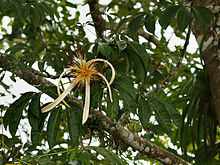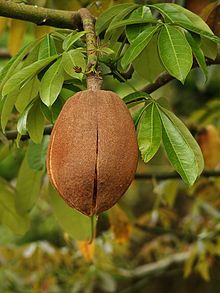- Pachira aquatica
-
Pachira aquatica 
Scientific classification Kingdom: Plantae (unranked): Angiosperms (unranked): Eudicots (unranked): Rosids Order: Malvales Family: Malvaceae Genus: Pachira Species: P. aquatica Binomial name Pachira aquatica
Aubl.Synonyms Carolinea macrocarpa
Bombax macrocarpum
Bombax glabrum
Pachira macrocarpaPachira aquatica is a tropical wetland tree of the genus Pachira, native to Central and South America where it grows in swamps. It is known by the common names Malabar chestnut, Guiana chestnut, provision tree, saba nut, Monguba (Brazil), Pumpo (Guatemala) and is commercially sold under the name money tree and money plant. It is classified in the subfamily Bombacoideae of the family Malvaceae. Previously it was assigned to Bombacaceae. [1] [2]
Contents
Characteristics
Pachira aquatica can grow up to 18 m (59.1 ft) in height in the wild. It has shiny green palmate leaves with lanceolate leaflets and smooth green bark. Its showy flowers have long, narrow petals that open like a banana peel to reveal hairlike yellowish orange stamens. The tree is cultivated for its edible nuts which grow in a very large, woody pod. The nuts are light brown, striped with white. They are said to taste like peanuts, and can be eaten raw or cooked or ground into a flour to make bread. The leaves and flowers are also edible.
The tree grows well as a tropical ornamental in moist, frost-free areas, and can be started from seed or cutting. It is a durable plant and will adapt very well to different conditions. The pachira needs plenty of sunlight though it is important to avoid direct sunlight during the summer months as the leaves may get sunburned.
Role in East Asian culture
In East Asia, Pachira aquatica (Chinese: 馬拉巴栗; pinyin: Mǎlābā lì; literally "Malabar chestnut") is often referred to as the "money tree" (發財樹 fācái shù). The tree had long been popular as an ornamental in Japan. In 1986, a Taiwanese truck driver first cultivated five small trees in a single flowerpot with their trunks braided. The popularity of these ornamentals took off in Japan and later much of the rest of East Asia. They are symbolically associated with good financial fortune and are typically seen in businesses, sometimes with red ribbons or other auspicious ornamentation attached. The trees play an important role in Taiwan's agricultural export economy with exports of NT$250 million (US$7 million) in 2005.[3]
Name
The genus name is derived from a language spoken in Guyana.[4] The species name is Latin for "aquatic".
The name "money tree" seems to refer to a story of its origin, where a poor man prayed for money, found this "odd" plant, took it home as an omen, and made money selling plants grown from its seeds.[5]
Notes
- ^ IABIN
- ^ GRIN
- ^ "Fancy take on money trees puts Taiwan on the map." Taiwan Headlines reprint from Liberty Times. 23 March 2006. Accessed 10 February 2007.
- ^ Helmut Genaust (1983): Etymologisches Wörterbuch der botanischen Pflanzennamen, 2. Auflage. Birkhäuser Verlag - ISBN 3-7643-1399-4
- ^ http://www.natureperfect.com/shop/money_tree_bonsai.html
References
- "Class effort gives Taiwan world leadership in 'money tree' exports." Taiwan Headlines reprint from United Daily News. 9 February 2006. Accessed 10 February 2007.
- "Fancy take on money trees puts Taiwan on the map." Taiwan Headlines reprint from Liberty Times. 23 March 2006. Accessed 10 February 2007.
- "Malabar Chestnut" at California Rare Fruit Growers Fruit Facts
- "Pachira aquatica" at FloriData
- Van Wyk, Ben-Erik (2005). Food Plants of the World. Portland, Oregon: Timber Press, Inc. ISBN 0-88192-743-0
External links
Categories:- Bombacoideae
- Edible nuts and seeds
- Trees of Central America
- Trees of South America
- Trees of Guatemala
Wikimedia Foundation. 2010.

